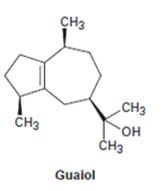
Concept explainers
a)

Interpretation:
At what positions the terpenoid guaiol will be labeled if isopentyl diphosphate and dimethylallyl diphosphate from which they are synthesized are isotopically labeled at the diphosphate bearing carbon atom (C1).
Concept introduction:
In the formation of terpenes every fourth carbon of one dimethylallyl phosphate (formed by the isomerization of isopentyl diphosphate) combines with the first carbon of the isopentyl phosphate molecule. Hence if the diphosphate bearing carbon is labeled, every fourth carbon in a terpene will be a labeled carbon.
To give:
The positions at which the terpenoid guaiol will be labeled if isopentyl diphosphate and dimethylallyl diphosphate from which it is synthesized are isotopically labeled at the diphosphate bearing carbon atom (C1).
b)

Interpretation:
At what positions the terpenoid sabinene will be labeled if isopentyl diphosphate and dimethylallyl diphosphate from which they are synthesized are isotopically labeled at the diphosphate bearing carbon atom (C1).
Concept introduction:
In the formation of terpenes every fourth carbon of one dimethylallyl phosphate (formed by the isomerization of isopentyl diphosphate) combines with the first carbon of the isopentyl phosphate molecule. Hence if the diphosphate bearing carbon is labeled, every fourth carbon in a terpene will be a labeled carbon.
To give:
The positions at which the terpenoid sabinene will be labeled if isopentyl diphosphate and dimethylallyl diphosphate from which it is synthesized are isotopically labeled at the diphosphate bearing carbon atom (C1).
Want to see the full answer?
Check out a sample textbook solution
Chapter 27 Solutions
Student Value Bundle: Organic Chemistry, + OWLv2 with Student Solutions Manual eBook, 4 terms (24 months) Printed Access Card (NEW!!)
- give the products for each of the followingarrow_forwardProvide the products and/or reagents for the following transformations. NaOMe HCl/EtOH OH NaOMe CI Show the product for the formation of the ketal given below for the transformation, showing all intermediates and resonance structures would be required to transform the ketal back to the starting ketone and then the mechanism What reagents/conditions HCI EtOH (excess)arrow_forwardMake meta-dibromobenze from nitrobenzene using amine reactions. *see imagearrow_forward
- Provide the structure of the expected major and minor (if any) products for each reaction. Clearly indicate stereochemistry where warranted. + + heat heat 이요 HNO3 1. AlCl3 2. H₂O H2SO4 1. AlCl3arrow_forward) Give the mechanism for the acid catalyzed hydrolysis of the following to the corresponding carboxylic acid. Show all intermediates and resonance structures N H+, H2O (excess)arrow_forward# 2. Drow full structures of the organic product expected in each of the following reactions. Draw the appropriate stereoisomer where warranted! Tos Cl O C NaCN PCC శ్రీ CI TSCI Pyridine H₂CrO4 PBrj Pyridine NaCNarrow_forward
- PLEASE help. Locate a literature IR spectrum of eugenol. Insert the literature spectrum here: What conclusions can you draw about your clove oil from these IR spectra? I attached my data belowarrow_forwardplease help and the percent recovery of clove oil from cloves is 4.61% and i have attached my ir spectrum as well. Based on your GC data, how many components are in the clove oil? Calculate the percentage of each component. Clearly show your work. Which of the components corresponds to eugenol? How do you know? Is eugenol the major component?arrow_forwardplease help and i am so confused if the picture is the gc data or ir spectrum. you dont have to do everything just what you can please because i am lost and the mass of the cloves was Mass of cloves 62.299g. Mass of recovered clove oil 62.761g.arrow_forward

 Introduction to General, Organic and BiochemistryChemistryISBN:9781285869759Author:Frederick A. Bettelheim, William H. Brown, Mary K. Campbell, Shawn O. Farrell, Omar TorresPublisher:Cengage Learning
Introduction to General, Organic and BiochemistryChemistryISBN:9781285869759Author:Frederick A. Bettelheim, William H. Brown, Mary K. Campbell, Shawn O. Farrell, Omar TorresPublisher:Cengage Learning Organic ChemistryChemistryISBN:9781305580350Author:William H. Brown, Brent L. Iverson, Eric Anslyn, Christopher S. FootePublisher:Cengage Learning
Organic ChemistryChemistryISBN:9781305580350Author:William H. Brown, Brent L. Iverson, Eric Anslyn, Christopher S. FootePublisher:Cengage Learning


